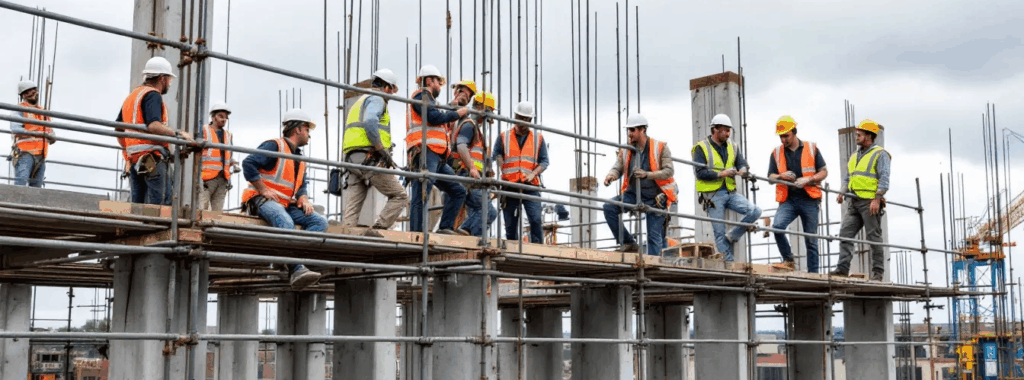
Scaffold Accident: Complete Guide to Prevention, Liability, and Legal Rights
Scaffold accidents cause over 4,500 injuries and 60+ deaths annually in the U.S. These accidents occur when scaffolding systems fail, collapse, or when workers fall from scaffolds during construction activities. In this guide, you’ll learn what scaffold accidents are, their common causes, prevention strategies, and your legal rights if injured.
We cover accident types, OSHA statistics, liability factors, and compensation rights that every construction worker and employer needs to understand. With over 2.3 million workers (65% of the industry) working on construction sites with scaffolds frequently, accident prevention isn’t just recommended—it’s critical for saving lives and preventing severe injuries.
According to the U.S. Bureau of Labor Statistics, scaffold-related incidents account for approximately one in ten construction site fatalities, making this knowledge essential for anyone working on construction sites.
Understanding Scaffold Accidents: Key Concepts and Definitions
A scaffold accident refers to any unintended event causing injury, fatality, or property damage when scaffolding is involved during construction or building maintenance activities. Scaffolding accidents can involve multiple failure types and typically result in serious injuries due to the height factor involved.
Key terminology includes:
- Scaffolding collapse: Complete or partial structural failure of scaffold systems
- Fall protection: Safety systems designed to prevent or arrest falls from height
- OSHA standards: Federal regulations governing scaffold safety (29 CFR 1926.451)
- System failure: Breakdown of scaffold components, materials, or safety equipment
Scaffold accidents involve three main types of scaffolding:
- Supported scaffolds: Using poles, frames, and braces for ground support
- Suspended scaffolds: Hanging from overhead anchor points
- Mobile scaffolds: Wheeled systems that can be moved between locations
Accident Categories and Relationships
Scaffold accidents connect to broader construction safety and legal topics through a clear relationship chain: improper installation → system failure → worker falls → severe injuries → legal liability and workers’ compensation claims.
These accidents relate directly to:
- Workers’ compensation law for injured workers
- Personal injury lawsuits against negligent parties (in New York, Labor Law Section 240, known as the Scaffold Law, not only governs construction employers’ obligations to protect workers at heights, but it also gives those workers the right to seek compensation for any injury or death caused by a fall or an object that fell from a height)
- OSHA compliance and occupational safety regulations
- Construction site liability among contractors and employers (in New York City, Labor Law Section 240, known as the Scaffold Law, not only governs construction employers’ obligations to protect workers at heights, but it also gives those workers the right to seek compensation for any injury or death caused by a fall or an object that fell from a height)
Why Scaffold Accident Prevention is Critical in Construction
OSHA data reveals that falls cause 33% of all construction fatalities nationally, with scaffold-related falls representing a significant portion of these deaths. Research shows that about 25% of workers injured in scaffolding accidents sustain moderate to severe traumatic brain injuries, while many others suffer spinal cord injuries, broken bones, and internal injuries.
The financial impact extends beyond medical expenses:
- Average workers’ compensation claims for scaffold accidents exceed $75,000
- OSHA fines for scaffold violations can reach $136,532 per serious violation
- Lost productivity and project delays create additional costs for employers
- Personal injury lawsuits can result in settlements exceeding $1 million for severe injuries
Statistical analysis shows construction workers face five times higher fatality rates than workers in other industries, with scaffold accidents contributing significantly to this disparity. Companies that implement comprehensive scaffold safety protocols see accident rates drop by up to 40% according to safety administration studies.
Key Statistics and Accident Cause Comparison Table
| Accident Cause Category | Percentage of Incidents | Common Injury Types | Average Recovery Time | Typical Compensation Range |
|---|---|---|---|---|
| System Failures (Equipment defects, improper assembly) | 45% | Broken bones, traumatic brain injuries | 6-18 months | $50,000-$500,000 |
| Human Factors (Inadequate training, safety protocol violations) | 40% | Falls, lacerations, spinal injuries | 3-12 months | $25,000-$300,000 |
| Environmental Factors (Weather, falling objects) | 15% | Multiple trauma, electrocution | 12+ months | $100,000-$1,000,000+ |
Research indicates that over 70% of scaffold accidents involve human factors, while system failures account for the most severe injuries and fatalities.
Step-by-Step Guide to Preventing Scaffold Accidents
Step 1: Pre-Installation Safety Assessment
Before scaffold erection begins, conduct comprehensive safety evaluations:
- OSHA inspection requirements: Ensure qualified personnel design scaffolds over 125 feet high
- Foundation stability checks: Verify ground conditions can support scaffold loads plus four times the intended working load
- Weather condition assessments: Postpone installation during high winds (over 25 mph) or severe weather
- Component inspection checklist:
- Examine all scaffold materials for defects or damage
- Verify proper fall arrest systems are available
- Confirm guardrails, platforms, and access ladders meet OSHA standards
- Check that all safety equipment is properly certified
Step 2: Proper Installation and Safety Measures
Follow OSHA Subpart L compliance requirements during scaffold erection:
- Structural integrity protocols: Properly brace and anchor scaffolds to prevent tip-over
- Fall protection installation: Install guardrails, midrails, and toeboards on all platforms over 10 feet high
- Safe access provisions: Provide proper ladders or stairways for worker access to scaffold platforms
- Load capacity verification: Ensure scaffolds can support their own weight plus intended loads without failure
Recommended tools include certified torque wrenches for proper component assembly, fall arrest systems for each worker, and weather monitoring equipment for ongoing safety assessments.
Step 3: Ongoing Monitoring and Maintenance
Implement daily inspection protocols and documentation:
- Daily safety inspections: Trained personnel must inspect scaffolds before each work shift
- Weather-related procedures: Modify or suspend work during adverse conditions
- Documentation requirements: Maintain inspection logs and incident reports
- Performance metrics: Track near-misses, safety training completion, and accident rates
Monitor wind speeds, ice formation, and structural integrity continuously to prevent accidents before they occur.
Common Mistakes That Cause Scaffold Accidents
Inadequate worker training on scaffold safety protocols and fall protection: Many employers fail to provide comprehensive training on proper scaffold use, fall arrest systems, and hazard identification. Workers need specific training on the scaffolding they’ll use.
Using damaged or improperly maintained scaffold components without inspection: Continuing to use scaffolds with defective materials, missing guardrails, or damaged platforms creates immediate hazards that lead to collapses and serious injuries.
Ignoring environmental factors like wind, ice, and temperature changes: Weather conditions significantly affect scaffold stability. Failing to adjust work practices for environmental hazards results in preventable accidents.
Pro Tip: Implement daily safety briefings, mandatory fall protection use, and immediate reporting of unsafe conditions to avoid these fatal errors. Train all workers to identify and control hazards before they lead to accidents.
Workers’ Compensation Benefits for Construction Accidents
Construction workers who are injured on the job may be entitled to workers’ compensation benefits covering medical expenses, rehabilitation, and a portion of lost wages (up to two-thirds of salary in New York). Benefits may also extend to survivors in the event of a fatal accident. However, workers don’t always receive the full benefits they deserve, and some claims are denied outright. For this reason, it’s important to consult a construction accident lawyer if you’ve been injured on the job.
Additional Legal Options for Injured New York Construction Workers
Beyond workers’ compensation, injured construction workers in New York may have other legal remedies. Depending on the circumstances, they may pursue a personal injury lawsuit for additional compensation or a wrongful death claim on behalf of a loved one. New York’s Labor Laws provide further protections, allowing lawsuits in cases where unsafe workplace conditions or negligence by construction companies or property owners led to injury. A construction accident lawyer can help workers understand these laws and navigate the process to ensure their rights are fully protected.
Real-Life Scaffold Accident Case Study
Case Study: Bechtel Texas LNG Project Triple Fatality
In a devastating scaffold accident, three workers fell 65-85 feet when scaffolding failed during maintenance work on an LNG facility. The accident occurred despite the project’s established safety protocols being in place.
Project Setup and Initial Conditions:
- Workers were performing routine maintenance on elevated equipment
- A suspended scaffolding system was installed by certified contractors
- Fall arrest systems were available, but not properly utilized
- Weather conditions were within acceptable parameters
Safety Protocol Failures Leading to Collapse:
- Inadequate anchor point inspection failed to identify structural weaknesses
- Workers bypassed fall protection equipment due to perceived inconvenience
- The supervisor failed to enforce mandatory safety briefings
- Emergency response procedures were not immediately activated
Investigation Findings and Legal Consequences: The investigation revealed multiple OSHA violations, including inadequate fall protection, improper scaffold assembly, and insufficient training for workers. Legal outcomes included:
- $2.8 million in OSHA fines for safety violations
- Wrongful death settlements exceeding $15 million for families
- Criminal charges filed against supervisory personnel
- Company-wide safety protocol overhaul mandated
This case illustrates how multiple safety failures can combine to produce catastrophic consequences, underscoring the crucial importance of comprehensive accident prevention measures.
Contact the Law Office of Nicholas E. Tzaneteas
As experienced New York City, Bronx, Brooklyn, Queens, and Manhattan construction accident attorneys and a personal injury law firm, we can help victims of construction site injuries. Nicholas Tzaneteas has assisted injured clients in recovering millions of dollars in judgments and settlements.
FAQs About Scaffold Accidents
Q: Who is liable when a scaffold accident occurs on a construction site?
A: Multiple parties can be held responsible, including general contractors, scaffolding companies, employers, and individual workers, depending on negligence factors. Liability often depends on who failed to follow safety protocols, maintain equipment properly, or provide adequate training.
Q: What compensation can I receive after a scaffold accident injury?
A: Workers’ compensation covers medical bills and lost wages regardless of fault, while personal injury lawsuits may provide additional damages for pain and suffering against negligent third parties. Compensation varies based on the severity of the injury and its long-term impacts.
Q: How long do I have to file a claim after a scaffold accident?
A: Workers’ compensation claims must typically be filed within 30 days of the accident, while the time frame for personal injury lawsuits in New York is up to 3 years. Immediate action protects your legal rights.
Q: What are the most common injuries from scaffold accidents?
A: TBIs, spinal cord damage, broken bones, and internal injuries are typical results of scaffold falls and collapses. About 25% of scaffold accident victims suffer moderate to severe head injuries requiring extensive medical treatment.

